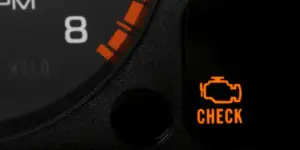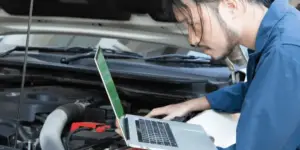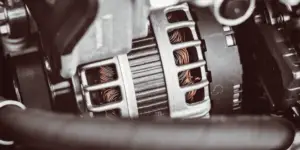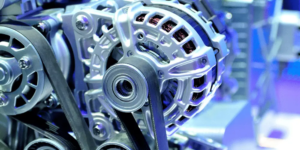This article will explore what signs to look out for if you suspect your alternator’s diode or diodes are bad.
Very briefly, alternator diodes convert the AC current created by the rotor winding and turn it into DC. DC is what your car’s electronics rely on to power it as it is driven.
Occasionally the diodes fail, and AC is sent to other car electronics, causing damage.
This is normally caused by faulty diodes or a bad voltage regulator. Often these two alternator components fail together.
We have broken this article into three main sections as this is the timeline that diagnosing a faulty diode normally takes.
The engine will begin to feel rough and have less power. Eventually, it will stop running and won’t start back up. The battery warning light will come on. Dimmer headlights result from lower battery voltage.
Signs of A Bad Alternator Diode
Bad Alternator Diode Sound
Bad alternator diodes make a whining or whistling sound when they go bad. The more diodes that are bad, the worst the sound will be.
One sure way to check is to rev the engine and see if the intensity of the whining increases.
Increased whining will happen because the higher RPMs will cause the alternator to work harder, causing the diodes to convert more AC to DC.
Bad Alternator Diode Smell
Although a burning electrical or rubber smell can be the symptom of many car problems, if it accompanies a whining sound as you increase the RPM, it is likely to show that the alternator diodes are bad.
This smell can be quite subtle, unlike the whistling sound, so you might have to get close to the alternator to see if the smell is emanating from it.
Poor Car Electrical System Performance
When an alternator starts to go bad, it soon shows in the performance of your electrical systems.
If the diodes aren’t converting the electrical current well enough. In that case, it will generate additional heat inside the alternator, which can also affect the headlights and the air conditioning.
You may notice that the instrument panel lights dim and power windows, and seat performance becomes sporadic.
You may notice static on your car audio system too.
Battery Drains Overnight
You may park your car at night, and everything has been working perfectly fine on the journey home. However, when you try and start in the morning, your car’s battery is flat.
This can be caused by an alternator diode going bad, and over many hours, it will suck the power from the battery back to the alternator, basically doing its job in reverse.
This is called a parasitic draw. This happens when the diode gets stuck in the way wrong position.
Diodes are, in fact, one-way valves in effect and should only allow charge to go one way.
Many people end up replacing a battery, thinking it’s faulty, only to find the new one also gets depleted quickly overnight.
It is always best to check the alternator and the battery simultaneously before replacing either.
Visual Inspection of A Bad Alternator Diode
A visual inspection is generally beyond most DIY mechanics, but you will need a scope if you want to perform this yourself. You don’t have to remove the alternator from the car to do this check.
It would be best to buy an oscillating multimeter that costs around $60 to perform this check. The device will show you what current pattern is occurring within the alternator.
If all the diodes are good, you will get a reading on the display of what looks like many humps that are all the same size and the same distance apart.
You will get various other patterns if there is an issue with one or more diodes, either open, shorting, or reversing.
A more detailed explanation can be found in this helpful article here https://www.toyotaguru.us/engine-control-systems/diode-tests.html
There is no real visual inspection you can do to check the condition of a diode.
Not only is it time-consuming to take the alternator off the car you also have to open up the casing to look inside.
Unless you already have the alternator off the car, this is something that isn’t worth your time.
If you have got the alternator off the car, you can check the diodes for excess heat or corrosion signs. In extreme cases, the excess heat can burn away the metal casing of the diode.
Most modern alternators have six diodes contained in two plates. So each plate has three diodes in it.
Most car shops will advise replacing the whole plate rather than any individual diodes within that plate or rectifier, as it makes more economic sense.
You don’t want to be in a position where you’ve paid for an alternator rebuild only to find that some parts that could have been replaced very cheaply weren’t. You now have a problem that requires another inspection and new parts – that could have been fitted before – to be fitted again.
Alternators generally last between 5 and 7 years or 80,000 to 150,000 miles, depending on how many times they have circuited the battery.
If your alternator is in this age range, it may be best to replace it as you will likely encounter additional problems with your current old alternator very soon.
What Causes An Alternator Diode To Fail
Battery Lead Errors and Jumpstarting
Your car’s battery has a negative and positive terminal for a good reason. If the cables are fitted incorrectly, the charge can be sent back to the alternator from the battery, causing diodes to blow.
The diode’s purpose is to ensure that the flow only goes one way from the alternator to the battery. They can’t tolerate charge coming to them from the battery.
It’s very important to ensure that you connect the cables from the donor car correctly when you are jump-starting your battery. Errors can send a positive charge to the alternator resulting in the diodes being unable to cope and failing.
Continued Heat
Using many electrical systems in your car in one go puts a lot of strain on the alternator.
This causes heat, and heat will eventually burn out the diodes. Many car owners add high electrical requiring mods to their cars and wisely choose to fit aftermarket high output alternators.
High output alternators cost more money, but standard alternators will continually fail if asked to do more current rectifying than they are designed for.
Many visitors read this article next: 7 Causes of A Hot Car Alternator – Troubleshooter Guide
Dry Solders
Diodes are soldered in place onto the rectifying bridge. Even during normal operations, they will become dry and fail eventually.
There is very little that can be done about this. It is just general wear and tear. Each time the diode heats, it expands slightly, and when it cools, it can crack.
What Happens When Alternator Diodes Fail
A bad diode can cause overheating in the alternator and cause electrical components to fail prematurely.
This usually is coupled with a fault in the voltage regulator. Often a diode going out and a faulty voltage regulator go hand in hand.
If this does happen, too much current could be sent through to other electrical systems causing them to short out, resulting in extensive repairs.
The main victim is the battery, where continued draining can cause the battery to stop holding an adequate charge, resulting in it being unable to start the car when you want to.
A bad alternator diode will not fix itself, so a delay in repair or replacement is a false economy.
The additional strain it puts on other components and the discharging of the battery will mean a larger repair bill unless action is taken to rectify it.
What’s The Cost To Replace An Alternator Diode
The good news is alternator diodes are cheap. Even from a good manufacturer such as a Bosch, a rectifier bridge containing three diodes will only set you back $30.
Labor costs can be quite expensive.
Expect to pay in the region of $200 to replace the diodes. You might also need to consider that you could be without your car for a few days while the repair is completed.
Many visitors also read these related articles: The Job of An Alternator Diode: Myths vs Facts
In conclusion
The most common signs of a bad alternator diode are
- Battery draining overnight
- Alternator whining or whistling
- Alternator electrical burning smell caused by overheating













